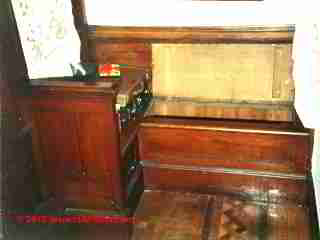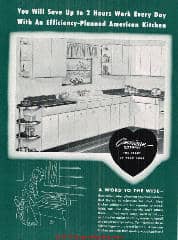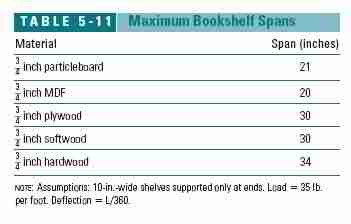 Best Practices Guide to Installing Interior Casework, Cabinets, Shelving
Best Practices Guide to Installing Interior Casework, Cabinets, Shelving
- POST a QUESTION or COMMENT about building casework, cabinets, shelving - best practices guide
Cabinets & Shelving Best Practices:
This article discusses choices of materials to use for building interior cabinets and shelving: casework, and describes best practices for building these components. This article series discusses and provides a best construction practices guide to the selection and installation of building interior surface materials, carpeting, doors, drywall, trim, flooring, lighting, plaster, materials, finishes, and sound control materials.
Our page top photo shows site-built casework in a Poughkeepsie, NY home constructed in 1900 (DJF).
InspectAPedia tolerates no conflicts of interest. We have no relationship with advertisers, products, or services discussed at this website.
- Daniel Friedman, Publisher/Editor/Author - See WHO ARE WE?
Casework: Guide to Selecting Materials for Built-In Cabinets & Shelving
 As described in the book, Best Practices Guide to Residential Construction (Steve Bliss, J Wiley & Sons) Chapter 5, Interior Finish:
As described in the book, Best Practices Guide to Residential Construction (Steve Bliss, J Wiley & Sons) Chapter 5, Interior Finish:
For shelving, built-ins, and other casework, contractors can choose from a wide array of panel products.
The most widely used are veneer-core plywood, MDF, and particleboard. MDF and particleboard are available either unfinished or with a wood veneer or melamine facing. Medium density overlay (MDO) is a good option for cabinets exposed to very high humidity or exterior uses.
Illustration: from AMERICAN KITCHENS CATALOG 1950 [PDF] [Click to enlarge any image]
Using Veneer-Core Plywood For Built-In Casework: Cabinets & Shelving
Cabinet-grade plywood typically has five inner plies (more for better grades), plus the face veneers, and in most cases uses phenol-formaldehyde adhesive, which has negligible off-gassing.
Plywood is strong and dimensionally stable. For paint-grade cabinets, birch plywood remains an excellent choice.
Baltic birch plywood uses all birch for the inner plies, is free of voids, and can be edge sanded, making it ideal for drawer sides and similar applications. For
stain-grade work, hardwood plywood can be special ordered with matched veneers.
Where screwing into edges is required, 7-ply material is less likely to split.
Using MDF (Medium Density Fiberboard) For Built-In Casework: Cabinets & Shelving
Medium-density fiberboard is a fine composite material made from fine wood fibers and resin, usually urea-formaldehyde (see description on page 184). MDF is available as both a paint-grade panel or faced with wood veneer or melamine.
Because of its competitive pricing and good workability, MDF is now the dominant panel product in many markets. In paint-grade work, the edges need to be sealed or banded due to high absorption of paint. Concerns about off-gassing of formaldehyde could be a concern to customers with allergies or chemical sensitivities.
However, if laminated on all faces with an impervious facing, such as melamine, or finished with two or more coats of varnish or an oil-based paint (or paint rated as a vapor barrier) on all faces, the off-gassing will be minimized.
Guide to using Particleboard For Built-In Casework: Cabinets & Shelving
Particleboard is similar to MDF, but with larger fibers, so it doesn’t machine to a crisp edge and leaves a noticeable texture when painted. Also, edges and corners are more prone to chipping than with MDF. Like MDF, it off-gasses urea-formaldehyde. Sealing all surfaces will minimize the problem.
Guide to using MDO (Medium Density Overlay) For Built-In Casework: Cabinets & Shelving
Medium-density overlay is an exterior grade plywood with a durable resin-treated paper facing that takes paint exceptionally well. It is widely used for sign making as well as concrete forms. Though not typically used in casework, it is an ideal material for cabinets that will be exposed to extreme moisture or exposed to weather on porches, patios, or other outdoor locations.
Recommendations for Constructing Built-in Shelving
 Typical shelf spans for simple shelves sitting
on cleats at both ends are shown in Table 5-11.
Typical shelf spans for simple shelves sitting
on cleats at both ends are shown in Table 5-11.
[Click to enlarge any image]
These assume a load of heavy books and minimal deflection, although long-term deflection under a constant load may be greater.
To stiffen shelving, it can be supported along the back edge or reinforced in front with solid-wood facing, glued and nailed in place.
For example, a 1 1/4-inch solid-wood apron along the front edge will increase the span for plywood shelving to about 36 inches.
- - Adapted with permission from Best Practices Guide to Residential Construction (Steve Bliss, J Wiley & Sons) .
Resources: Manufacturers, Industry Associations, & Sources of Indoor Wall Materials, Flooring, Carpeting, Lighting, Sound Control Materials
Drywall Trims and Accessories
- Clinch-On Products, A Deitrich Metal Framing Company www.dietrichindustries.com Nail-on and clinch-on galvanized metal corner beads
- Con-Form International/Strait Flex www.straitflex.com Strait-Flex fiber-composite mud-on corner bead for inside and outside off-90 degree angles
- Drywall Systems International www.no-coat.com No-Coat prefinished drywall tapes for inside and outside corners, off angles and bullnose trims
- Flex-Ability Concepts www.flexc.com Curved metal top and bottom plates for curved wood or metal stud walls
- Grabber Construction Products www.grabberman.com Drywall screws, corner clips, and fiberglass mesh tapes
- Insta Arch Corp. www.instaarch.com Galvanized steel preformed and custom arches for drywall
- National Gypsum Co. www.nationalgypsum.com ProForm tapes and finishing compounds
- Pla-Cor www.pla-cor.com ABS corner trims, bullnose, 3-way corner caps, and flexible arches
- Phillips Manufacturing Co. www.phillipsmfg.com Metal and vinyl corner beads, bullnose trim, and flexible bullnose and angled arch trim
- Trim-Tex www.trim-tex.com Vinyl drywall beads, flexible arch beads, and finishing accessories
- U.S. Gypsum Beadex and Sheetrock-brand tape-on metal corner beads and trims. Complete line of drywall finishing compounds
- Vinyl Corp., A Deitrich Metal Framing Company www.vinylcorp.com Full line of vinyl beads and trim
Polymer (Urethane), MDF, and Vinyl Trim Producers & Sources
- Burton Mouldings www.burton-mouldings.com MDF(medium-density fiberboard), polymer, flex, and wood
- Fypon www.fypon.com Polymer moldings and components
- Nu-Wood www.nu-wood.com Polymer moldings and components
- Outwater Plastics www.outwater.com Polymer moldings and components
- RAS Industries www.rasindustries.com Polymer moldings and components
- Royal Mouldings (formerly Marley Mouldings) www.royalmouldings.com Polymer, polystyrene, expanded-PVC, CPVC, and acrylic molding profiles and components
Flexible Trim Manufacturers & Sources
- Flex Trim www.flextrim.com Flexible polymer moldings
- Resin Art www.resinart.com Flexible polymer moldings
Industry & Trade Associations for Carpeting, Lighting, Finishes, Wood Products, Flooring, Painting & Decorating
- American Lighting Association www.americanlightingassoc.com
- Association of the Wall and Ceiling Industries - Web: awci.org
- Carpet and Rug Institute (CRI) www.carpet-rug.org
- Drywall Finishing Council www.dwfc.org
- Forest Stewardship Program www.fscus.org
- FloorFacts www.floorfacts.com
- The Gypsum Association www.gypsum.org
- National Oak Flooring Manufacturers Association (NOFMA) www.nofma.com
- National Wood Flooring Association www.woodfloors.org
- Painting and Decorating Contractors of America www.pdca.org Smartwood/Rainforest Alliance www.smartwood.org
- - Adapted with permission from Best Practices Guide to Residential Construction (Steve Bliss, J Wiley & Sons) . by Steven Bliss, courtesy of Wiley & Sons.
Also see INTERIORS of buildings, our home page for information about all topics relating to building interiors.
...
Continue reading at CABINETS & COUNTERTOPS - topic home, or select a topic from the closely-related articles below, or see the complete ARTICLE INDEX.
Or see these
Recommended Articles
- AMERICAN KITCHENS CATALOG 1950 [PDF] steel kitchen cabinets dont' warp, swell or rot ... and they're easier to clean and never need painting. Less costly than wood cabinets.
- CABINETS & COUNTERTOPS - home
- CABINET CHOICES, Bath / Kitchen
- CABINET DESIGN GUIDE, KITCHEN
- CABINET DOOR HINGES
- CABINET FALLING HAZARDS
- CABINET INSTALLATION & REPAIR MANUALS
- CABINET MOLD & WATER DAMAGE
- CASEWORK, CABINETS, SHELVING INSTALLATION
- COUNTERTOPS, KITCHEN & BATH
- FORMALDEHYDE GAS HAZARD REDUCTION
- DOORS, INTERIOR
- FORMICA COUNTERTOPS CATALOG 1950 [PDF]
- MIAMI CAREY BATH CABINETS CATALOG 1950 [PDF]
- YOUNGSTOWN KITCHENS CATALOG 1950 [PDF]
Suggested citation for this web page
CASEWORK, CABINETS, SHELVING INSTALLATION at InspectApedia.com - online encyclopedia of building & environmental inspection, testing, diagnosis, repair, & problem prevention advice.
Or see this
INDEX to RELATED ARTICLES: ARTICLE INDEX to BATH & KITCHEN
Or use the SEARCH BOX found below to Ask a Question or Search InspectApedia
Ask a Question or Search InspectApedia
Questions & answers or comments about building casework, cabinets, shelving - best practices guide.
Try the search box just below, or if you prefer, post a question or comment in the Comments box below and we will respond promptly.
Search the InspectApedia website
Note: appearance of your Comment below may be delayed: if your comment contains an image, photograph, web link, or text that looks to the software as if it might be a web link, your posting will appear after it has been approved by a moderator. Apologies for the delay.
Only one image can be added per comment but you can post as many comments, and therefore images, as you like.
You will not receive a notification when a response to your question has been posted.
Please bookmark this page to make it easy for you to check back for our response.
IF above you see "Comment Form is loading comments..." then COMMENT BOX - countable.ca / bawkbox.com IS NOT WORKING.
In any case you are welcome to send an email directly to us at InspectApedia.com at editor@inspectApedia.com
We'll reply to you directly. Please help us help you by noting, in your email, the URL of the InspectApedia page where you wanted to comment.
Citations & References
In addition to any citations in the article above, a full list is available on request.
- Steve Bliss's Building Advisor at buildingadvisor.com helps homeowners & contractors plan & complete successful building & remodeling projects: buying land, site work, building design, cost estimating, materials & components, & project management through complete construction. Email: info@buildingadvisor.com
Steven Bliss served as editorial director and co-publisher of The Journal of Light Construction for 16 years and previously as building technology editor for Progressive Builder and Solar Age magazines. He worked in the building trades as a carpenter and design/build contractor for more than ten years and holds a masters degree from the Harvard Graduate School of Education. Excerpts from his recent book, Best Practices Guide to Residential Construction, Wiley (November 18, 2005) ISBN-10: 0471648361, ISBN-13: 978-0471648369, appear throughout this website, with permission and courtesy of Wiley & Sons. Best Practices Guide is available from the publisher, J. Wiley & Sons, and also at Amazon.com - Our recommended books about building & mechanical systems design, inspection, problem diagnosis, and repair, and about indoor environment and IAQ testing, diagnosis, and cleanup are at the InspectAPedia Bookstore. Also see our Book Reviews - InspectAPedia.
- America's Favorite Homes, mail-order catalogues as a guide to popular early 20th-century houses, Robert Schweitzer, Michael W.R. Davis, 1990, Wayne State University Press ISBN 0814320066 (may be available from Wayne State University Press)
- American Plywood Association, APA, "Portland Manufacturing Company, No. 1, a series of monographs on the history of plywood manufacturing",Plywood Pioneers Association, 31 March, 1967, www.apawood.org
- Best Practices Guide to Residential Construction, by Steven Bliss. John Wiley & Sons, 2006. ISBN-10: 0471648361, ISBN-13: 978-0471648369, Hardcover: 320 pages, available from Amazon.com and also Wiley.com. See our book review of this publication.
- Building Research Council, BRC, nee Small Homes Council, SHC, School of Architecture, University of Illinois at Urbana-Champaign, brc.arch.uiuc.edu. "The Small Homes Council (our original name) was organized in 1944 during the war at the request of the President of the University of Illinois to consider the role of the university in meeting the demand for housing in the United States. Soldiers would be coming home after the war and would be needing good low-cost housing. ... In 1993, the Council became part of the School of Architecture, and since then has been known as the School of Architecture-Building Research Council. ... The Council's researchers answered many critical questions that would affect the quality of the nation's housing stock.
- How could homes be designed and built more efficiently?
- What kinds of construction and production techniques worked well and which did not?
- How did people use different kinds of spaces in their homes?
- What roles did community planning, zoning, and interior design play in how neighborhoods worked
- Construction Drawings and Details, Rosemary Kilmer
- "An Example of Colonial Paneling", Norman Morrison Isham, The Metropolitan Museum of Art Bulletin, Vol. 6, No. 5 (May, 1911), pp. 112-116, available by JSTOR.
- Lath & Plaster Systems [copy on file as /interiors/LathPlaster_Nat_Gypsum.pdf ] - , 092300/NGC, National Gypsum Lath and Plaster Systems, National Gypsum Corporation, 800-628-4662 describing National Gypsum's Kal-Kore brand plaster base
- Piquet Wall Construction: involving timber-framed wall construction with long top girts, diagonal timber bracing, and small diameter logs placed vertically along with concrete chinking to fill in the wall plane.
- Plastering Skills, F. Van Den Branden, Thomas L. Hartsell, Amer Technical Pub (July 1, 1985), ISBN-10: 0826906575, ISBN-13: 978-0826906571 [purchase at Amazon.com]
- The Stairway Manufacturers' Association, (877) 500-5759, provides a pictorial guide to the stair and railing portion of the International Residential Code. [copy on file as http://www.stairways.org/pdf/2006%20Stair%20IRC%20SCREEN.pdf ] -
- What Style Is It?: A Guide to American Architecture, Rev., John C. Poppeliers, S. Allen Chambers, Wiley; Rev Sub edition (October 6, 2003), ISBN-10: 0471250368, ISBN-13: 978-0471250364
- In addition to citations & references found in this article, see the research citations given at the end of the related articles found at our suggested
CONTINUE READING or RECOMMENDED ARTICLES.
- Carson, Dunlop & Associates Ltd., 120 Carlton Street Suite 407, Toronto ON M5A 4K2. Tel: (416) 964-9415 1-800-268-7070 Email: info@carsondunlop.com. Alan Carson is a past president of ASHI, the American Society of Home Inspectors.
Thanks to Alan Carson and Bob Dunlop, for permission for InspectAPedia to use text excerpts from The HOME REFERENCE BOOK - the Encyclopedia of Homes and to use illustrations from The ILLUSTRATED HOME .
Carson Dunlop Associates provides extensive home inspection education and report writing material. In gratitude we provide links to tsome Carson Dunlop Associates products and services.

